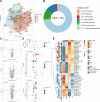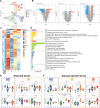Lipidomic and transcriptomic profiling reveal alterations in the coexistence of gestational diabetes mellitus and preeclampsia impacting maternal and neonatal outcomes
- PMID: 40715462
- PMCID: PMC12297449
- DOI: 10.1038/s41598-025-12077-5
Lipidomic and transcriptomic profiling reveal alterations in the coexistence of gestational diabetes mellitus and preeclampsia impacting maternal and neonatal outcomes
Abstract
Gestational diabetes mellitus (GDM) and preeclampsia (PE) are common pregnancy complications, with the rising incidence of GDM and the pronounced heterogeneity of PE leading to an increased prevalence of their coexistence, presenting a unique and complex clinical condition. However, the disease characteristics and maternal-neonatal outcomes of this comorbidity remain largely unknown. In this study, we collected peripheral blood samples from 42 pregnant women, including pregnant controls without complications (Control, n = 10), GDM (n = 12), PE (n = 10), and those with coexistence of GDM and PE (PG, n = 10), as well as partial neonatal cord blood samples. Through integrated lipidomic and transcriptomic analyses, we identified distinct lipid and gene expression features associated with PG state and explored their correlations with clinical maternal characteristics and neonatal outcomes. Our findings indicate that PE and PG groups exhibit more pronounced lipidomic alterations, which are associated with adverse neonatal outcomes, while GDM and PG groups show more significant transcriptomic changes related to maternal neuronal and immune dysfunction, potentially increasing the risk of postpartum depression (PD). The elevated risk of PD was further supported by independent analyses of the UK Biobank and FinnGen cohorts. Despite the limitation of a modest sample size, the study provides evidence that subclinical alterations in maternal peripheral blood lipidomic and transcriptomic profiles, along with aberrations in cord blood gas (CBG) parameters, may exert adverse effects on both maternal and neonatal health. These findings highlight the need for further mechanistic and longitudinal investigations to elucidate the underlying pathophysiological processes.
Keywords: Gestational diabetes mellitus; Lipidomics; Neonatal outcomes; Preeclampsia; Transcriptomics.
© 2025. The Author(s).
Conflict of interest statement
Declarations. Competing interests: The authors declare no competing interests.
Figures






Similar articles
-
Deciphering Shared Gene Signatures and Immune Infiltration Characteristics Between Gestational Diabetes Mellitus and Preeclampsia by Integrated Bioinformatics Analysis and Machine Learning.Reprod Sci. 2025 Jun;32(6):1886-1904. doi: 10.1007/s43032-025-01847-1. Epub 2025 May 15. Reprod Sci. 2025. PMID: 40374866
-
Screening for gestational diabetes mellitus based on different risk profiles and settings for improving maternal and infant health.Cochrane Database Syst Rev. 2017 Aug 3;8(8):CD007222. doi: 10.1002/14651858.CD007222.pub4. Cochrane Database Syst Rev. 2017. PMID: 28771289 Free PMC article.
-
Exercise for pregnant women with gestational diabetes for improving maternal and fetal outcomes.Cochrane Database Syst Rev. 2017 Jun 22;6(6):CD012202. doi: 10.1002/14651858.CD012202.pub2. Cochrane Database Syst Rev. 2017. PMID: 28639706 Free PMC article.
-
Combined diet and exercise interventions for preventing gestational diabetes mellitus.Cochrane Database Syst Rev. 2017 Nov 13;11(11):CD010443. doi: 10.1002/14651858.CD010443.pub3. Cochrane Database Syst Rev. 2017. PMID: 29129039 Free PMC article.
-
Different intensities of glycaemic control for women with gestational diabetes mellitus.Cochrane Database Syst Rev. 2016 Apr 7;4(4):CD011624. doi: 10.1002/14651858.CD011624.pub2. Cochrane Database Syst Rev. 2016. Update in: Cochrane Database Syst Rev. 2023 Oct 10;10:CD011624. doi: 10.1002/14651858.CD011624.pub3. PMID: 27055233 Free PMC article. Updated.
References
-
- Chorell, E. et al. Pregnancy to postpartum transition of serum metabolites in women with gestational diabetes. Metabolism72, 27–36 (2017). - PubMed
MeSH terms
Substances
Grants and funding
LinkOut - more resources
Full Text Sources
Research Materials
Miscellaneous

